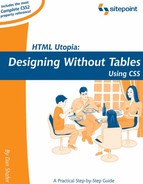7.1. Who's in Charge Here?
Under the rules of CSS2, user settings trump designer specifications every time. While it's important to keep this in mind, it's also important to realize that simple recognition of this fact doesn't provide any insight into how to design with the rule in mind. Simply put, you can't do so.
The user can set his or her preferences for colors particularly easily. All the modern browsers have simple color preference-setting panels, like that of Internet Explorer 5 for the Macintosh shown in Figure 7-1.
Figure 7-1. Typical Preference Setting Panel for User to Define Colors

The top portion of the preference panel in Figure 7-1 allows the user to set colors for text, page background, links that have been read and links that have not yet been visited. In the section of the preference panel labeled "Page Content", you can see that the user can either allow your fonts and colors to override his or her preference, or not. If those two checkboxes are unchecked, the user preferences take precedence.
The preference panel in Figure 7-1 allows the user to choose a great many settings to express his or her preference for how pages look. Notice, too, that users can define their own style sheet, and tell the browser to use this to override any conflicting styles it finds on incoming pages. In such a situation, if the user defines a style for <h1> elements that defines a color but not a font, for example, your font setting will be used, but the user's color will be applied whether or not your style sheet defines one.
In all the information that follows in this part of the book, then, you need to keep in mind the caveat, "…unless the user overrides your settings." I won't bore you by reminding you of this rule repeatedly.
